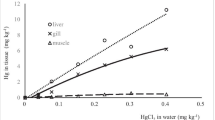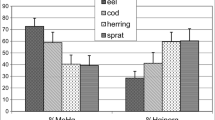Abstract
In natural waters and in breeding tanks certain substances are naturally present in the water or deliberately added to it. Some of these substances are characterized by the formation of strong complexes with mercury and thus they can reduce the intake of mercury by aquatic organisms. The accumulation of mercury in six selected tissues (skin, scales, kidneys, muscle, liver and gills) of Cyprinus carpio L. in the presence of humic acid and sodium chloride was studied. Carp fingerlings were exposed in fish tanks for 3 days to the bulk solution containing a defined concentration of Hg2+ (1.5 μg/l) and increasing concentration of humic acid (0–5 mg/l) and chloride ions (18–600 mg/l). The fish were not fed during the experiment and mercury accumulated in the carp tissues from fish tank water only. Total mercury content in water and in selected tissues was determined by the atomic absorption spectrometer AMA 254. Increased concentration of both humic acid and sodium chloride caused reduction of mercury accumulation in carp tissues up to 93 and 45%, respectively.


Similar content being viewed by others
References
Alhashemi AH, Sekhavatjou MS, Kiabi BH, Karbassi AR (2012) Bioaccumulation of trace elements in water, sediment, and six fish species from a freshwater wetland, Iran. Microchem J 104:1–7
Allen P (1994) Accumulation profiles of lead and the influence of cadmium and mercury in Oreochromis aureus (Steindacher) during chronic exponsure. Toxicol Environ Chem 44:101–112
Ardakani SS, Jafari SM (2014) Assessment of heavy metals (Cu, Pb and Zn) in different tissues of common carp (Cyprinus carpio) caught from Shirinsu Wetland, Western Iran. J Chem Heal Ris 4:47–54
Block M, Pärt P, Glynn AW (1997) Influcence of water quality on the accumulation of methyl 203Mercury in gill tissues of Minnow (Phoxinus phoxinus). Comp Biochem Physiol 118:197–197
Celechovska O, Svobodova Z, Zlabek V, Macharackova B (2007) Distribution of metals in tissues of the common carp (Cyprinus carpio L.). Acta Vet Brno 76:93–100
Cervený D, Zlabek V, Velisek J, Turek J, Grabic R, Grabicova K, Fedorova G, Rosmus J, Lepic P, Randak T (2014) Contamination of fish in important fishing grounds of the Czech Republic. Ecotoxicol Environ Saf 109:101–109
Clesceri LS, Greenberg AE, Eaton AD (1998) Standard methods for the examination of water and wastewater, 20th edn. American Public Health Association Inc., Washington D.C., USA
Dutton J, Fisher NS (2012) Influence of humic acid on the uptake of aqueous metals by the killifish (Fundulus heteroclitus). Environ Toxicol Chem 31:2225–2232
Fernandez-Gomez C, Bayona JM, Diez S (2015) Diffusive gradients in thin film for predicting methylmercury bioavailability in freshwaters after photodegradation. Chemosphere 131:184–191
Ghosh D, Mandal DK (2012) Histopathological effects and bioaccumulation of mercury in the kidney of an Indian Major Carp, Labeo rohita (Hamilton). Bull Environ Contam Toxicol 89:479–483
Guo L, Hunt BJ, Santschi PH, Ray SM (2001) Effect of dissolved organic matter on the uptake of trace metals by American oysters. Environ Sci Technol 35:885–893
Kensova R, Celechovska O, Doubravova J, Svobodova Z (2010) Concentration of metals in tissues of fish from the věstonice reserovoir. Acta Vet Brno 79:335–345
Luider CD, Crusius J, Playle RC, Curtis PJ (2004) Influence of natural organic matter source on copper speciation as demonstrated by Cu binding to fish gills, by ion selective electrode, and by DGT gel sampler. Environ Sci Technol 38:2865–2872
Mieiro CL, Pacheco M, Pereira ME, Duarte AC (2009) Mercury distribution in key tissues of fish (Liza aurata) inhabiting a contaminated estuary—implications for human and ecosystem health risk assessment. J Environ Monit 11:1004–1012
Ravichandran M (2004) Interactions between mercury and dissolved organic matter—a review. Chemosphere 55:319–331
Sari M, Tuzen M (2009) Biosorptive removal of mercury(II) from aqueous solution using lichen (Xanthoparmelia conspersa) biomass: kinetic and equilibrium studies Original Research Article. J Hazard Mater 169(1–3):263–270
Seline NE (2009) Global biochemical cycling of mercury: a review. Annu Rev Env Resour 34:43–63
Spehar RL, Christensen GM, Curtis C, Lemke AE, Norbert TJ, Pickering QH (1998) Effects of pollution on freshwater fish. J Water Pollut Control Fed 54:877–922
Spurny P, Mares J, Hedbavny J, Sukop I (2002) Heavy metal distribution in the ecosystems of the upper course Jihlava River. Czech J Anim Sci 47:160–167
Svobodova Z, Vykusova B, Machova J, Bastl J, Hrbkova M, Svobodnik J (1993) Monitoring of foreign substances in fishes from the Jizera River in the Otradovice locality. Bull VURH Vodňany Czech Repub 29:28–42
Svobodova Z, Piacka V, Vykusova B, Machova J, Hejtmanek M, Hrbkova M, Bastl J (1995) Residues of pollutants in siluriformes from various localities of the Czech Republic. Acta Vet Brno 64:195–208
Svobodova Z, Zlabek V, Celechovska O, Randak T, Machova J, Kolarova J (2002) Content of metals in tissues of marketable common carp and in bottom sediments of selected ponds of South and West Bohemia. Czech J Anim Sci 47:339–350
Svobodova Z, Celechovska O, Kolarova J, Randak T, Zlabek V (2004) Assessment of metal contamination in the upper reaches of the Tichá Orlice River. Czech J Anim Sci 49:458–464
Svobodova Z, Kolarova J, Navratil S, Vesely T, Chloupek P, Tesarcik J, Citek J (2007) Nemoci sladkovodnich a akvarijnich ryb. Informatorium, Czech Republic
Syversen T, Kaur P (2012) The toxicology of mercury and its compounds. J Trace Elem Med Biol 26:215–226
Taravati S, Sary AA, Baboli MJ (2012) Determination of lead, mercury and cadmium in wild and farmed Barbus sharpeyi from Shadegan wetland and Azadegan aquaculture site, South of Iran. Bull Environ Contam Toxicol 89:78–81
Tuzen M, Karaman I, Citak D, Soylak M (2009a) Mercury(II) and methyl mercury determinations in water and fish samples by using solid phase extraction and cold vapour atomic absorption spectrometry combination. Food Chem Toxicol 47(7):1648–1652
Tuzen M, Uluozlu OD, Karaman I, Soylak M (2009b) Mercury(II) and methyl mercury speciation on Streptococcus pyogenes loaded Dowex Optipore SD-2. J Hazard Mater 169(1–3):345–350
Tuzen M, Sari A, Mendel D, Soylak M (2009c) Removal of mercury(II) from aqueous solution using moss (Drepanocladus revolvens) biomass: equilibrium, thermodynamic and kinetic studies Original Research Article. J Hazard Mater 171(1–3):500–507
Velcheva IG (2006) Zinc content in the organs and tissues of freshwater fish from the Kardjali and Studen Kladenets Dam Lakes in Bulgaria. Turk J Zool 30:1–7
Visnjic-Jeftic Z, Jaric IL, Skoric S (2010) Heavy metal and trace element accumulation in muscle, liver and gills of the Pontic shad (Alosa immaculata Bennett 1835) from the Danube River (Serbia). Microchem J 95:341–344
Watanabe N, Tayama M, Inouye M, Yasutake A (2012) Distribution and chemical form of mercury in commercial fish tissues. J Toxicol Sci 37:853–861
WHO (1991) Inorganic mercury. Environmental health criteria 118. International programme on Chemical Safety. World Health Organization, Geneva
Zhou Q, Zhang J, Fu J, Shi J, Jiang G (2008) Biomonitoring: an appealing tool for assessment of metal pollution in the aquatic ecosystem. Anal Chim Acta 606:135–150
Acknowledgements
This research was financially supported by Project No. QJ1210013 National Agency for Agricultural, Ministry of Agriculture Czech Republic.
Author information
Authors and Affiliations
Corresponding author
Rights and permissions
About this article
Cite this article
Vičarová, P., Dočekalová, H., Poštulková, E. et al. Reduction of Mercury Accumulation in Carp Tissues (Cyprinus carpio L.) by Natural Organic Matter and Chlorides. Int J Environ Res 12, 127–133 (2018). https://doi.org/10.1007/s41742-018-0076-0
Received:
Revised:
Accepted:
Published:
Issue Date:
DOI: https://doi.org/10.1007/s41742-018-0076-0




